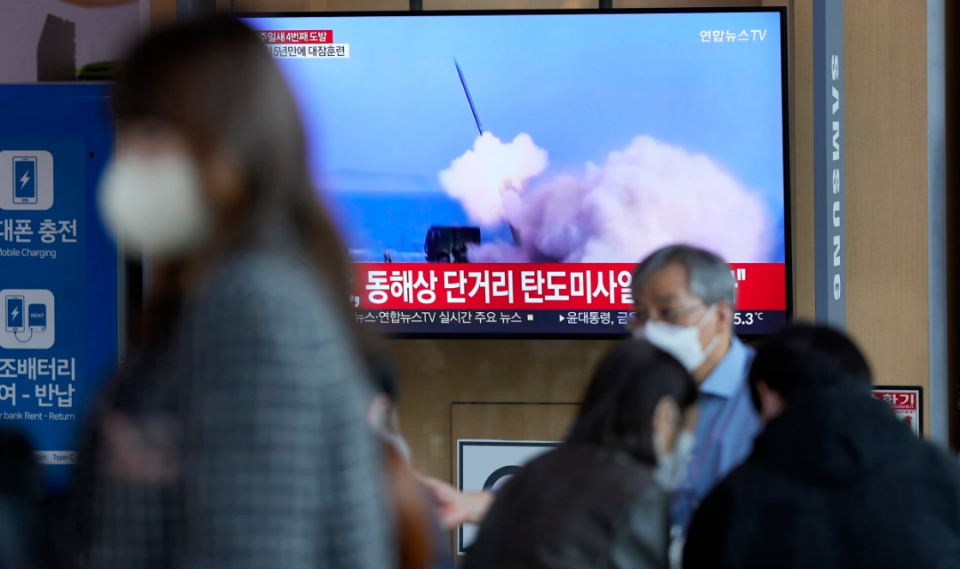
Seoul issues warning to evacuate as North Korea launches at least 10 missiles

Three hours after North Korea fired more than 10 missiles Wednesday, including one that landed close to South Korea’s waters that President Yoon Suk-yeol said was ‘effectively a territorial invasion, Seoul issued an air raid warning for Ulleungdo — flashed on national television — urging its residents to “evacuate to the nearest underground shelter”.
North Korea and South Korea have both fired missiles landing in waters off each other’s coasts for the first time. After Pyongyang launched a missile that landed less than 60km (37mi) off the South’s city of Sokcho, Seoul retaliated. The South’s military said this was an “unacceptable” breach of its territory. It fired three air-to-ground missiles in response, which officials said landed a similar distance past the Northern Limit Line (NLL), the de facto maritime border between the two countries.
North Korea’s veiled threat to use nuclear weapons
The demarcation line is considered to be the rough midway-point in the sea between North and South Korea. The North, however, has never accepted the boundary. On Tuesday, North Korea warned that South Korea and the US would pay “the most horrible price in history” if they continued joint military drills, which has largely been seen as a veiled threat to use nuclear weapons.
Also read: Japan issues alert as North Korea fires ballistic missiles towards sea
The North is expected to resume nuclear weapons testing soon after a five-year break, with US and South Korean intelligence saying that Pyongyang has completed all the necessary preparations. The South military claimed it was the “first time since the peninsula was divided” — after hostilities in the Korean War came to an end in 1953 — that a North Korean missile had come thus near to the South’s territorial waters.
South Korea holds ‘aggressive’ meeting
After the missiles were fired, South Korean President Yoon Suk-yeol called a meeting of the National Security Council over the launch, which analysts said was one of the most “aggressive and threatening” in many years. Yoon underlined that North Korea’s provocation was effectively a territorial invasion. He ordered “swift and stern measures so that North Korea’s provocations pay a clear price.”
The missile that was closest to South Korea landed in waters just 57 kilometers (35 miles) east of the South Korean mainland, the military said. The military released a statement describing the missile launch near South Korean territorial waters as “very rare and intolerable”. “Our military vowed to respond firmly to this (provocation),” it added.
The South Korean military’s Joint Chiefs of Staff initially said it detected the launch of three short range ballistic missiles. But it later announced North Korea had fired “at least 10 missiles of various types today towards the east and west”. Confirming North Korean missile launches, Japan’s Prime Minister Fumio Kishida told reporters he planned to call a “national security meeting as soon as possible.”
Escalation in hostilities
The missile exchange between the two countries come during a period of national mourning in South Korea, following the crowd crush in Seoul at the weekend which killed more than 150 people. The firings are a marked escalation in hostilities across the peninsula this year, which has already witnessed over 50 missile launches from North Korea, including one ballistic missile that passed over Japan. On Monday a US nuclear-powered submarine arrived off the coast of South Korea as part of the joint US-South Korean drills, which began in August.
Also read: Seoul stampede death toll rises to 151 president declares national mourning
Pyongyang’s latest missile launch also comes as Seoul and Washington stage their largest-ever joint air drills, dubbed “Vigilant Storm”, which involve hundreds of warplanes from both sides. The Vigilant Storm air drills were preceded by 12 days of amphibious naval exercises.
In March 2010, a North Korean submarine torpedoed the South Korean naval vessel Cheonan, killing 46 sailors, including 16 who were on their mandatory military service. In November of the same year, the North shelled a South Korean border island, killing two marines —both of them young conscripts.
The test follows a recent blitz of launches, including what the North said were tactical nuke drills that Washington and Seoul have repeatedly warned could culminate in another nuclear test — which would be Pyongyang’s seventh.


